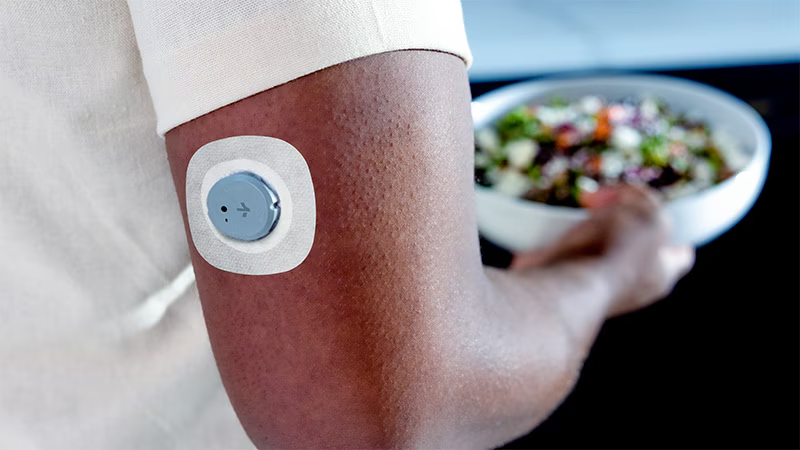The launch of the first over-the-counter (OTC) continuous glucose monitor (CGM) marks a significant milestone in diabetes care. This innovation has the potential to revolutionize how people with diabetes manage their condition, making glucose monitoring more accessible and convenient. In this blog, we’ll explore the implications of this new CGM technology, its benefits, and the potential challenges that come with it.
The Rise of Continuous Glucose Monitoring
In terms of diabetes care, continuous glucose monitoring has revolutionized the field. Unlike traditional blood glucose meters, which require finger pricks to measure glucose levels, CGMs provide real-time glucose data throughout the day and night. This technology helps patients better understand their glucose patterns, enabling them to make more informed decisions about their diet, exercise, and insulin therapy.
How CGMs Work
CGMs monitor the amount of glucose in the interstitial fluid by inserting a tiny sensor beneath the skin. The sensor sends data to a wearable device or smartphone app, providing continuous updates on the user’s glucose levels. This information is crucial for managing diabetes effectively, as it helps prevent dangerous highs and lows, known as hyperglycemia and hypoglycemia, respectively.
The Significance of Over-the-Counter Access
The introduction of an OTC CGM is a monumental step forward in diabetes care. Previously, CGMs were only available through a prescription, which meant that patients had to go through their healthcare providers to obtain one. This often involved navigating insurance approvals, which could be a lengthy and frustrating process. The availability of an OTC CGM eliminates these barriers, making it easier for people with diabetes to access this life-changing technology.
Benefits of OTC CGMs
Increased Accessibility
With OTC availability, more people with diabetes can easily purchase and use a CGM without needing a prescription. This is especially beneficial for those who may not have regular access to healthcare providers or those with limited insurance coverage.
Cost-Effectiveness
OTC CGMs may be more affordable for patients who previously faced high out-of-pocket costs due to insurance limitations. The ability to purchase a CGM directly can lead to cost savings and improved diabetes management.
Empowerment and Independence
OTC CGMs empower patients to take control of their diabetes care. By removing the need for a prescription, patients can independently monitor their glucose levels and make informed decisions about their health.
Challenges and Considerations
While the launch of the first OTC CGM is a significant advancement, it also presents some challenges that need to be addressed.
Ensuring Proper Usage
One concern with OTC CGMs is that some users may not receive the necessary training on how to use the device effectively. Proper usage is critical to obtaining accurate readings and making appropriate adjustments to diabetes management plans. Without guidance from a healthcare provider, there is a risk that patients may not fully understand how to interpret the data or respond to the readings.
More Read About Monumental Glucose Monitor Funding Decision for Diabetes Patients
Data Overload
Another potential challenge is data overload. CGMs provide a wealth of information, which can be overwhelming for some users. Patients who are not accustomed to analyzing glucose data may find it difficult to make sense of the readings and take appropriate actions. This underscores the importance of patient education and support, even for those using OTC CGMs.
The Impact on Diabetes Care
The launch of the first OTC continuous glucose monitor is likely to have a profound impact on diabetes care. By making CGMs more accessible, this development has the potential to improve health outcomes for millions of people with diabetes care.
Enhancing Self-Management
With more people using CGMs, there is an opportunity for widespread improvement in diabetes self-management. CGMs provide valuable insights into how food, exercise, stress, and other factors affect glucose levels, enabling patients to make better choices and reduce the risk of complications.
Reducing the Burden on Healthcare Systems
OTC CGMs could also help reduce the burden on healthcare systems. By empowering patients to manage their diabetes more effectively at home, there may be fewer emergency visits and hospitalizations related to poor glucose control. This could lead to cost savings for both patients and healthcare providers.
Future Directions
The introduction of the first OTC CGM is just the beginning. As technology continues to advance, we can expect to see even more innovations in diabetes care. Future developments may include CGMs with longer sensor life, improved accuracy, and additional features that further enhance the user experience.
The Role of Artificial Intelligence
One exciting area of development is the integration of artificial intelligence (AI) with CGMs. AI algorithms could analyze CGM data to provide personalized recommendations for insulin dosing, diet, and exercise. This could further enhance diabetes care management and improve patient outcomes.
Conclusion
The launch of the first over-the-counter continuous glucose monitor is a groundbreaking moment in diabetes care. This new technology has the potential to make glucose monitoring more accessible, affordable, and user-friendly for millions of people with diabetes. While challenges remain, the benefits of OTC CGMs are undeniable. As we move forward, it will be crucial to ensure that patients receive the support and education they need to make the most of this innovative tool. Ultimately, the widespread adoption of CGMs could lead to better health outcomes and a brighter future for those living with diabetes.


